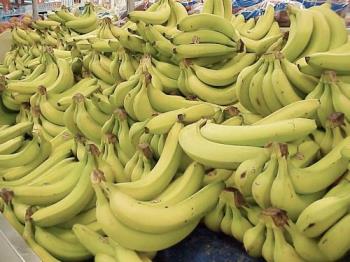The benefits of eating bananas
By jasjon
@jasjon (252)
Philippines
December 13, 2006 9:51pm CST
Bananas are a good source of both potassium and vitamin B6. They not only help to maintain bowel health, but are also good energy-boosting snacks. As bananas ripen, their starch is converted into sugar. Bananas help to maintain blood sugar levels and it is also a fruit which is easily digested.
How much banana should you eat?
Bananas can be eaten freely, within limits. A banana weighing 100 g contains about 62 calories. It must be remembered that dried bananas are a more concentrated source of nutrients than plain bananas.
Maximizing the benefits of banana
Fresh, ripe bananas are a very good source of fruit sugars and can give a quick energy boost.
8 responses
@cherrylicious (394)
• United Arab Emirates
2 Feb 07
Eating banana gives you an instant energy boost, one that lasts till next hour. It is recommended eating two pieces of banana before a strenous go minute workout.
Potasium a vital mineral found in this tropical fruit, improves brain power and reduce the risk of a stroke, cure hangover with a banana milksahke. It naturally calms the stomach while the milk re-hydrates the body. And a bit of honey to rebuild depleted blood sugar cells.
@anandsaab (590)
• India
15 Dec 06
Most bananas grown worldwide are used for local consumption. In the tropics, bananas, especially cooking bananas, represent a major source of food, as well as a major source of income for smallholder farmers. It is in the East African highlands that bananas reach their greatest importance as a staple food crop. In countries such as Uganda, Burundi and Rwanda per capita consumption has been estimated at 450 kg per year, the highest in the world. Ugandans use the same word "matooke" to describe both banana and food.
In the past, the banana was a highly sustainable crop with a long plantation life and stable yields year round. However with the arrival of the Black Sigatoka fungus, banana production in eastern Africa has fallen by over 40%. For example during the 1970s, Uganda produced 15 to 20 tonnes of bananas per hectare. Today production has fallen to only 6 tonnes per hectare.
The situation has started to improve as new disease resistant cultivars have been developed such as the FHIA-17 (known in Uganda as the Kabana 3). These new cultivars taste different from the traditionally grown banana which has slowed their acceptance by local farmers. However, by adding mulch and animal manure to the soil around the base of the banana plant, these new cultivars have substantially increased yields in the areas where they have been tried.
The Rockefeller Foundation has started trials for genetically modified banana plants that are resistant to both Black Sigatoka and banana weevils. It is developing cultivars specifically for smallholder or subsistence farmers.
@The_Sexy_Kid (122)
• India
26 Dec 06
Bananas are cultivated for their fruit which bear the same name. Globally, bananas rank forth after rice, wheat and maize in human consumption. They are grown in 130 countries worldwide, more then any other fruit crop. Bananas come in a variety of sizes and colours. The fruit averages 125 grams out of which 75 % is water and 25 % dry matter content. This fruit is benefitial because it contains a valuable source of Vitamin A, Vitamin B6, Vitamin C and Potassium. This fruit is considered as a medicine to many diseases by the people of South East Asian countries like Malaysia, Indonesia, Singapore and Brunei.
@sadate (35)
• India
2 Feb 07
Bananas are great for people with hypertension problems. Those that tend towards high blood sugar levels, however, need to be careful of eating too much at one go.
@vishnukompella836 (160)
• India
14 Dec 06
Banana is the common name used for herbaceous plants in the genus Musa, which because of their size and structure, are often mistaken for trees. Bananas are cultivated for their fruit which bear the same name, and to a lesser extent for the production of fibre and as ornamental plants. Bananas are of the family Musaceae. Globally, bananas rank fourth after rice, wheat and maize in human consumption; they are grown in 130 countries worldwide, more than any other fruit crop. Bananas are native to tropical southeastern Asia but are widely cultivated in tropical regions. In popular culture and commerce, "banana" usually refers to the soft, sweet "dessert" bananas that are usually eaten raw. The bananas from a group of cultivars with firmer, starchier fruit, generally used in cooking rather than eaten raw, are typically known as plantains. Bananas may also be dried and ground into banana flour.
The main or upright growth is called a pseudostem, which when mature, will obtain a height of 2–8 m (varies between different cultivars), with leaves of up to 3.5 m in length. Each pseudostem produces a single bunch of bananas, before dying and being replaced by a new pseudostem. The base of the plant is a rhizome (known as a corm). Corms are perennial, with a productive lifespan of 15 years or more.
The term banana is applied to both the plant and its elongated fruit (technically a false berry) which grow in hanging clusters, with up to 20 fruit to a tier (called a hand), and 5-20 tiers to a bunch. The total of the hanging clusters is known as a bunch, or commercially as a "banana stem", and can weigh from 30–50 kg. The fruit averages 125 g, of which approximately 75% is water and 25% dry matter content. Bananas are a valuable source of Vitamin A, Vitamin B6, Vitamin C, and potassium.
Although the wild species have fruits with numerous large, hard seeds, virtually all culinary bananas have seedless fruits. Bananas are classified either as dessert bananas (meaning they are yellow and fully ripe when eaten) or as green cooking bananas. Almost all export bananas are of the dessert types; however, only about 10-15% of all production is for export, with the U.S. and EU being the dominant buyers












